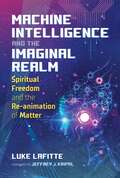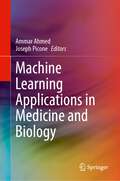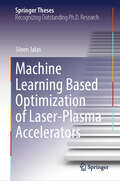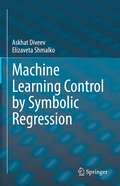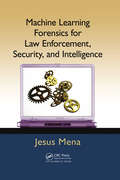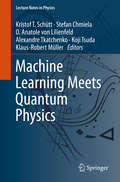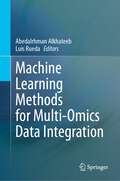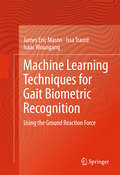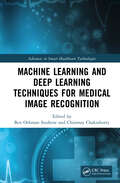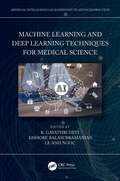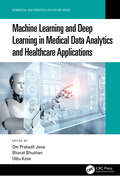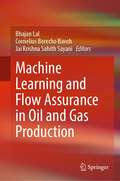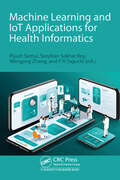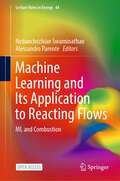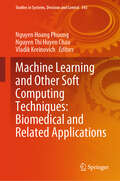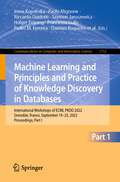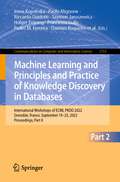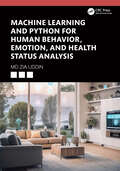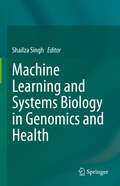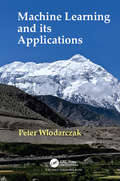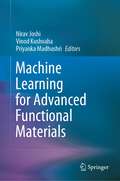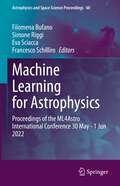- Table View
- List View
Machine Intelligence and the Imaginal Realm: Spiritual Freedom and the Re-animation of Matter
by Luke Lafitte• Explores how we naturally project consciousness onto machines and how this is reflected in human culture, science, artificial intelligence, and literature • Demonstrates a direct connection between consciousness and the history of machines in American history • Looks at the contributions and influence of Grace Hopper, Richard Feynman, Philip K. Dick, Nikola Tesla, Thomas Edison, Elon Musk, David Bohm, Norbert Wiener, and Steve Jobs as well as the Nag Hammadi Gnostic gospels Humans invented and constructed machines to aid them, as far back as the Stone Age. As the machines became more complex, they became extensions of the body and mind, and we naturally began projecting consciousness onto them. As Luke Lafitte shows in detail, although machines complicate the already complicated issue of identity, because they are &“ours&” and &“of us,&” they are part of our spiritual development. In this sweeping exploration of the history of the machine as a tool, as a transpersonal object to assist human activity, and as a transitional artifact between spirits and the humans who interact with them, Lafitte examines the role that machines play in the struggle between &“spiritual man&” and &“mechanical man&” throughout history. He interprets the messages, archetypes, and language of the unconscious in the first popular stories related to mechanical men, and he demonstrates a direct connection between consciousness and the history of machines in American history, specifically between the inventors of these machines and the awakening of our imaginations and our powers of manifestation. He examines the influence of Philip K. Dick, Nikola Tesla, Thomas Edison, Grace Hopper, Richard Feynman, Elon Musk, David Bohm, and others and shows how the Nag Hammadi gospels explain how we can take back our myth and spirit from the machine. Although the term &“mechanical man&” is a catch-all phrase, Lafitte shows that the term is also a meeting ground where extra-dimensional communications between different forms of matter occur. Every machine, android, robot, and cyborg arose from consciousness, and these mechanical men, whether real or fictive, offer us an opportunity to free ourselves from enslavement to materialism and awaken our imaginations to create our own realities.
Machine Learning Applications in Medicine and Biology
by Joseph Picone Ammar AhmedThis book combines selected papers from the 2022 IEEE Signal Processing in Medicine and Biology Symposium (IEEE SPMB) held at Temple University. The symposium presents multidisciplinary research in the life sciences. Topics covered include:Signal and image analysis (EEG, ECG, MRI)Machine learningData mining and classificationBig data resourcesApplications of particular interest at the 2022 symposium included digital pathology, computational biology, and quantum computing. The book features tutorials and examples of successful applications that will appeal to a wide range of professionals and researchers in signal processing, medicine, and biology.
Machine Learning Based Optimization of Laser-Plasma Accelerators (Springer Theses)
by Sören JalasThis book explores the application of machine learning-based methods, particularly Bayesian optimization, within the realm of laser-plasma accelerators. The book involves the implementation of Bayesian optimization to fine tune the parameters of the lux accelerator, encompassing simulations and real-time experimentation. In combination, the methods presented in this book provide valuable tools for effectively managing the inherent complexity of LPAs, spanning from the design phase in simulations to real-time operation, potentially paving the way for LPAs to cater to a wide array of applications with diverse demands.
Machine Learning Control by Symbolic Regression
by Askhat Diveev Elizaveta ShmalkoThis book provides comprehensive coverage on a new direction in computational mathematics research: automatic search for formulas. Formulas must be sought in all areas of science and life: these are the laws of the universe, the macro and micro world, fundamental physics, engineering, weather and natural disasters forecasting; the search for new laws in economics, politics, sociology. Accumulating many years of experience in the development and application of numerical methods of symbolic regression to solving control problems, the authors offer new possibilities not only in the field of control automation, but also in the design of completely different optimal structures in many fields. For specialists in the field of control, Machine Learning Control by Symbolic Regression opens up a new promising direction of research and acquaints scientists with the methods of automatic construction of control systems.For specialists in the field of machine learning, the book opens up a new, much broader direction than neural networks: methods of symbolic regression. This book makes it easy to master this new area in machine learning and apply this approach everywhere neural networks are used. For mathematicians, the book opens up a new approach to the construction of numerical methods for obtaining analytical solutions to unsolvable problems; for example, numerical analytical solutions of algebraic equations, differential equations, non-trivial integrals, etc. For specialists in the field of artificial intelligence, the book offers a machine way to solve problems, framed in the form of analytical relationships.
Machine Learning Forensics for Law Enforcement, Security, and Intelligence
by Jesus MenaIncreasingly, crimes and fraud are digital in nature, occurring at breakneck speed and encompassing large volumes of data. To combat this unlawful activity, knowledge about the use of machine learning technology and software is critical. Machine Learning Forensics for Law Enforcement, Security, and Intelligence integrates an assortment of deductive
Machine Learning Meets Quantum Physics (Lecture Notes in Physics #968)
by Klaus-Robert Müller Kristof T. Schütt Stefan Chmiela O. Anatole von Lilienfeld Alexandre Tkatchenko Koji TsudaDesigning molecules and materials with desired properties is an important prerequisite for advancing technology in our modern societies. This requires both the ability to calculate accurate microscopic properties, such as energies, forces and electrostatic multipoles of specific configurations, as well as efficient sampling of potential energy surfaces to obtain corresponding macroscopic properties. Tools that can provide this are accurate first-principles calculations rooted in quantum mechanics, and statistical mechanics, respectively. Unfortunately, they come at a high computational cost that prohibits calculations for large systems and long time-scales, thus presenting a severe bottleneck both for searching the vast chemical compound space and the stupendously many dynamical configurations that a molecule can assume. To overcome this challenge, recently there have been increased efforts to accelerate quantum simulations with machine learning (ML). This emerging interdisciplinary community encompasses chemists, material scientists, physicists, mathematicians and computer scientists, joining forces to contribute to the exciting hot topic of progressing machine learning and AI for molecules and materials. The book that has emerged from a series of workshops provides a snapshot of this rapidly developing field. It contains tutorial material explaining the relevant foundations needed in chemistry, physics as well as machine learning to give an easy starting point for interested readers. In addition, a number of research papers defining the current state-of-the-art are included. The book has five parts (Fundamentals, Incorporating Prior Knowledge, Deep Learning of Atomistic Representations, Atomistic Simulations and Discovery and Design), each prefaced by editorial commentary that puts the respective parts into a broader scientific context.
Machine Learning Methods for Multi-Omics Data Integration
by Luis Rueda Abedalrhman AlkhateebThe advancement of biomedical engineering has enabled the generation of multi-omics data by developing high-throughput technologies, such as next-generation sequencing, mass spectrometry, and microarrays. Large-scale data sets for multiple omics platforms, including genomics, transcriptomics, proteomics, and metabolomics, have become more accessible and cost-effective over time. Integrating multi-omics data has become increasingly important in many research fields, such as bioinformatics, genomics, and systems biology. This integration allows researchers to understand complex interactions between biological molecules and pathways. It enables us to comprehensively understand complex biological systems, leading to new insights into disease mechanisms, drug discovery, and personalized medicine. Still, integrating various heterogeneous data types into a single learning model also comes with challenges. In this regard, learning algorithms have been vital in analyzing and integrating these large-scale heterogeneous data sets into one learning model. This book overviews the latest multi-omics technologies, machine learning techniques for data integration, and multi-omics databases for validation. It covers different types of learning for supervised and unsupervised learning techniques, including standard classifiers, deep learning, tensor factorization, ensemble learning, and clustering, among others. The book categorizes different levels of integrations, ranging from early, middle, or late-stage among multi-view models. The underlying models target different objectives, such as knowledge discovery, pattern recognition, disease-related biomarkers, and validation tools for multi-omics data. Finally, the book emphasizes practical applications and case studies, making it an essential resource for researchers and practitioners looking to apply machine learning to their multi-omics data sets. The book covers data preprocessing, feature selection, and model evaluation, providing readers with a practical guide to implementing machine learning techniques on various multi-omics data sets.
Machine Learning Techniques for Gait Biometric Recognition
by Isaac Woungang James Eric Mason Issa TraoréThis book focuses on how machine learning techniques can be used to analyze and make use of one particular category of behavioral biometrics known as the gait biometric. A comprehensive Ground Reaction Force (GRF)-based Gait Biometrics Recognition framework is proposed and validated by experiments. In addition, an in-depth analysis of existing recognition techniques that are best suited for performing footstep GRF-based person recognition is also proposed, as well as a comparison of feature extractors, normalizers, and classifiers configurations that were never directly compared with one another in any previous GRF recognition research. Finally, a detailed theoretical overview of many existing machine learning techniques is presented, leading to a proposal of two novel data processing techniques developed specifically for the purpose of gait biometric recognition using GRF. This book · introduces novel machine-learning-based temporal normalization techniques · bridges research gaps concerning the effect of footwear and stepping speed on footstep GRF-based person recognition · provides detailed discussions of key research challenges and open research issues in gait biometrics recognition · compares biometrics systems trained and tested with the same footwear against those trained and tested with different footwear
Machine Learning and Deep Learning Techniques for Medical Image Recognition (Advances in Smart Healthcare Technologies)
by Ben Othman Soufiene and Chinmay ChakrabortyMachine Learning and Deep Learning Techniques for Medical Image Recognition comprehensively reviews deep learning-based algorithms in medical image analysis problems including medical image processing. It includes a detailed review of deep learning approaches for semantic object detection and segmentation in medical image computing and large-scale radiology database mining. A particular focus is placed on the application of convolutional neural networks with the theory and varied selection of techniques for semantic segmentation using deep learning principles in medical imaging supported by practical examples. Features: Offers important key aspects in the development and implementation of machine learning and deep learning approaches toward developing prediction tools and models and improving medical diagnosis Teaches how machine learning and deep learning algorithms are applied to a broad range of application areas, including chest X-ray, breast computer-aided detection, lung and chest, microscopy, and pathology Covers common research problems in medical image analysis and their challenges Focuses on aspects of deep learning and machine learning for combating COVID-19 Includes pertinent case studies This book is aimed at researchers and graduate students in computer engineering, artificial intelligence and machine learning, and biomedical imaging.
Machine Learning and Deep Learning Techniques for Medical Science (Artificial Intelligence (AI): Elementary to Advanced Practices)
by K. Gayathri DeviThe application of machine learning is growing exponentially into every branch of business and science, including medical science. This book presents the integration of machine learning (ML) and deep learning (DL) algorithms that can be applied in the healthcare sector to reduce the time required by doctors, radiologists, and other medical professionals for analyzing, predicting, and diagnosing the conditions with accurate results. The book offers important key aspects in the development and implementation of ML and DL approaches toward developing prediction tools and models and improving medical diagnosis. The contributors explore the recent trends, innovations, challenges, and solutions, as well as case studies of the applications of ML and DL in intelligent system-based disease diagnosis. The chapters also highlight the basics and the need for applying mathematical aspects with reference to the development of new medical models. Authors also explore ML and DL in relation to artificial intelligence (AI) prediction tools, the discovery of drugs, neuroscience, diagnosis in multiple imaging modalities, and pattern recognition approaches to functional magnetic resonance imaging images. This book is for students and researchers of computer science and engineering, electronics and communication engineering, and information technology; for biomedical engineering researchers, academicians, and educators; and for students and professionals in other areas of the healthcare sector. Presents key aspects in the development and the implementation of ML and DL approaches toward developing prediction tools, models, and improving medical diagnosis Discusses the recent trends, innovations, challenges, solutions, and applications of intelligent system-based disease diagnosis Examines DL theories, models, and tools to enhance health information systems Explores ML and DL in relation to AI prediction tools, discovery of drugs, neuroscience, and diagnosis in multiple imaging modalities Dr. K. Gayathri Devi is a Professor at the Department of Electronics and Communication Engineering, Dr. N.G.P Institute of Technology, Tamil Nadu, India. Dr. Kishore Balasubramanian is an Assistant Professor (Senior Scale) at the Department of EEE at Dr. Mahalingam College of Engineering & Technology, Tamil Nadu, India. Dr. Le Anh Ngoc is a Director of Swinburne Innovation Space and Professor in Swinburne University of Technology (Vietnam).
Machine Learning and Deep Learning in Efficacy Improvement of Healthcare Systems (Emerging Trends in Biomedical Technologies and Health informatics)
by Om Prakash JenaThe goal of medical informatics is to improve life expectancy, disease diagnosis and quality of life. Medical devices have revolutionized healthcare and have led to the modern age of machine learning, deep learning and Internet of Medical Things (IoMT) with their proliferation, mobility and agility. This book exposes different dimensions of applications for computational intelligence and explains its use in solving various biomedical and healthcare problems in the real world. This book describes the fundamental concepts of machine learning and deep learning techniques in a healthcare system. The aim of this book is to describe how deep learning methods are used to ensure high-quality data processing, medical image and signal analysis and improved healthcare applications. This book also explores different dimensions of computational intelligence applications and illustrates its use in the solution of assorted real-world biomedical and healthcare problems. Furthermore, it provides the healthcare sector with innovative advances in theory, analytical approaches, numerical simulation, statistical analysis, modelling, advanced deployment, case studies, analytical results, computational structuring and significant progress in the field of machine learning and deep learning in healthcare applications. FEATURES Explores different dimensions of computational intelligence applications and illustrates its use in the solution of assorted real-world biomedical and healthcare problems Provides guidance in developing intelligence-based diagnostic systems, efficient models and cost-effective machines Provides the latest research findings, solutions to the concerning issues and relevant theoretical frameworks in the area of machine learning and deep learning for healthcare systems Describes experiences and findings relating to protocol design, prototyping, experimental evaluation, real testbeds and empirical characterization of security and privacy interoperability issues in healthcare applications Explores and illustrates the current and future impacts of pandemics and mitigates risk in healthcare with advanced analytics This book is intended for students, researchers, professionals and policy makers working in the fields of public health and in the healthcare sector. Scientists and IT specialists will also find this book beneficial for research exposure and new ideas in the field of machine learning and deep learning.
Machine Learning and Deep Learning in Medical Data Analytics and Healthcare Applications (Biomedical and Robotics Healthcare)
by Om Prakash JenaMachine Learning and Deep Learning in Medical Data Analytics and Healthcare Applications introduces and explores a variety of schemes designed to empower, enhance, and represent multi-institutional and multi-disciplinary machine learning (ML) and deep learning (DL) research in healthcare paradigms. Serving as a unique compendium of existing and emerging ML/DL paradigms for the healthcare sector, this book demonstrates the depth, breadth, complexity, and diversity of this multi-disciplinary area. It provides a comprehensive overview of ML/DL algorithms and explores the related use cases in enterprises such as computer-aided medical diagnostics, drug discovery and development, medical imaging, automation, robotic surgery, electronic smart records creation, outbreak prediction, medical image analysis, and radiation treatments. This book aims to endow different communities with the innovative advances in theory, analytical results, case studies, numerical simulation, modeling, and computational structuring in the field of ML/DL models for healthcare applications. It will reveal different dimensions of ML/DL applications and will illustrate their use in the solution of assorted real-world biomedical and healthcare problems. Features: Covers the fundamentals of ML and DL in the context of healthcare applications Discusses various data collection approaches from various sources and how to use them in ML/DL models Integrates several aspects of AI-based computational intelligence such as ML and DL from diversified perspectives which describe recent research trends and advanced topics in the field Explores the current and future impacts of pandemics and risk mitigation in healthcare with advanced analytics Emphasizes feature selection as an important step in any accurate model simulation where ML/DL methods are used to help train the system and extract the positive solution implicitly This book is a valuable source of information for researchers, scientists, healthcare professionals, programmers, and graduate-level students interested in understanding the applications of ML/DL in healthcare scenarios. Dr. Om Prakash Jena is an Assistant Professor in the Department of Computer Science, Ravenshaw University, Cuttack, Odisha, India. Dr. Bharat Bhushan is an Assistant Professor of Department of Computer Science and Engineering (CSE) at the School of Engineering and Technology, Sharda University, Greater Noida, India. Dr. Utku Kose is an Associate Professor in Suleyman Demirel University, Turkey.
Machine Learning and Flow Assurance in Oil and Gas Production
by Bhajan Lal Cornelius Borecho Bavoh Jai Krishna Sahith SayaniThis book is useful to flow assurance engineers, students, and industries who wish to be flow assurance authorities in the twenty-first-century oil and gas industry.The use of digital or artificial intelligence methods in flow assurance has increased recently to achieve fast results without any thorough training effectively. Generally, flow assurance covers all risks associated with maintaining the flow of oil and gas during any stage in the petroleum industry. Flow assurance in the oil and gas industry covers the anticipation, limitation, and/or prevention of hydrates, wax, asphaltenes, scale, and corrosion during operation. Flow assurance challenges mostly lead to stoppage of production or plugs, damage to pipelines or production facilities, economic losses, and in severe cases blowouts and loss of human lives. A combination of several chemical and non-chemical techniques is mostly used to prevent flow assurance issues in the industry. However, the use of models to anticipate, limit, and/or prevent flow assurance problems is recommended as the best and most suitable practice. The existing proposed flow assurance models on hydrates, wax, asphaltenes, scale, and corrosion management are challenged with accuracy and precision. They are not also limited by several parametric assumptions. Recently, machine learning methods have gained much attention as best practices for predicting flow assurance issues. Examples of these machine learning models include conventional approaches such as artificial neural network, support vector machine (SVM), least square support vector machine (LSSVM), random forest (RF), and hybrid models. The use of machine learning in flow assurance is growing, and thus, relevant knowledge and guidelines on their application methods and effectiveness are needed for academic, industrial, and research purposes.In this book, the authors focus on the use and abilities of various machine learning methods in flow assurance. Initially, basic definitions and use of machine learning in flow assurance are discussed in a broader scope within the oil and gas industry. The rest of the chapters discuss the use of machine learning in various flow assurance areas such as hydrates, wax, asphaltenes, scale, and corrosion. Also, the use of machine learning in practical field applications is discussed to understand the practical use of machine learning in flow assurance.
Machine Learning and IoT Applications for Health Informatics
by Pijush Samui Zhang Wengang Sekhar Roy Sanjiban Taguchi Y HThis book brings together leading experts from around the world to explore the transformative potential of Machine Learning (ML) and the Internet of Things (IoT) in healthcare. It provides a platform for studying a future where healthcare becomes more precise, personalized, and accessible for all. The book covers recent advancements that will shape the future of healthcare and how artificial intelligence is revolutionizing disease detection, from analyzing chest X-rays for pneumonia to solving the secrets of our genes. It investigates the transformative potential of smart devices, real-time analysis of heart data, and personalized treatment plan creation. It shows how ML and IoT work and presents real-world examples of how they are leading to earlier and more accurate diagnoses and personalized treatments.Therefore, this edited book will be an invaluable resource for researchers, healthcare professionals, data scientists, or simply someone passionate about the future of healthcare. Readers will discover the exciting possibilities that lie ahead at the crossroads of ML, IoT, and health informatics.
Machine Learning and IoT: A Biological Perspective
by Shampa Sen, Leonid Datta and Sayak MitraThis book discusses some of the innumerable ways in which computational methods can be used to facilitate research in biology and medicine - from storing enormous amounts of biological data to solving complex biological problems and enhancing treatment of various grave diseases.
Machine Learning and Its Application to Reacting Flows: ML and Combustion (Lecture Notes in Energy #44)
by Nedunchezhian Swaminathan Alessandro ParenteThis open access book introduces and explains machine learning (ML) algorithms and techniques developed for statistical inferences on a complex process or system and their applications to simulations of chemically reacting turbulent flows.These two fields, ML and turbulent combustion, have large body of work and knowledge on their own, and this book brings them together and explain the complexities and challenges involved in applying ML techniques to simulate and study reacting flows. This is important as to the world’s total primary energy supply (TPES), since more than 90% of this supply is through combustion technologies and the non-negligible effects of combustion on environment. Although alternative technologies based on renewable energies are coming up, their shares for the TPES is are less than 5% currently and one needs a complete paradigm shift to replace combustion sources. Whether this is practical or not is entirely a different question, and an answer to this question depends on the respondent. However, a pragmatic analysis suggests that the combustion share to TPES is likely to be more than 70% even by 2070. Hence, it will be prudent to take advantage of ML techniques to improve combustion sciences and technologies so that efficient and “greener” combustion systems that are friendlier to the environment can be designed. The book covers the current state of the art in these two topics and outlines the challenges involved, merits and drawbacks of using ML for turbulent combustion simulations including avenues which can be explored to overcome the challenges. The required mathematical equations and backgrounds are discussed with ample references for readers to find further detail if they wish. This book is unique since there is not any book with similar coverage of topics, ranging from big data analysis and machine learning algorithm to their applications for combustion science and system design for energy generation.
Machine Learning and Other Soft Computing Techniques: Biomedical and Related Applications (Studies in Systems, Decision and Control #543)
by Vladik Kreinovich Nguyen Hoang Phuong Nguyen Thi Huyen ChauThis book contains applications to various health-related problems, from designing and maintaining a proper diet to enhancing hygiene to analysis of mammograms and left-right brain activity to treating diseases such as diabetes and drug addictions. Health issues are very important. So naturally whatever new data processing technique appears, researchers try to apply it to health issues as well. From this viewpoint, Artificial Intelligence (AI) and Computational Intelligence (CI) techniques are no exception: they have been successfully applied to medicine, and more promising applications are on the way. Applications of AI and CI techniques to health issues are the main focus of this book. Health issues are also very delicate, because human bodies are complex organisms. No matter how interesting and promising are new ideas and new techniques, there is always a possibility of unexpected side effects. Because of this, we cannot apply untested methods to patients, and we first need to test these methods on other less critical applications. Several book chapters describe such applications—whose success paves the way for these methods to be used in biomedical situations. These applications range from human/face detection to predicting student success to predicting election results to explaining the observed intensity of space light. We hope that this book helps practitioners and researchers to learn more about computational intelligence techniques and their biomedical applications—and to further develop this important research direction.
Machine Learning and Principles and Practice of Knowledge Discovery in Databases: International Workshops Of Ecml Pkdd 2021, Virtual Event, September 13-17, 2021, Proceedings, Part I (Communications In Computer And Information Science Series #1524)
by Lee Cooper Wouter Verbeke Rita Ribeiro Annalisa Appice Elio Masciari João Gama Riccardo Guidotti Pedro M. Ferreira Albert Bifet Ricard Gavaldà Ilaria Bordino Francesco Gullo Zbigniew Ras Slawomir Nowaczyk Giovanni Ponti Sepideh Pashami Holger Fröning Franz Pernkopf Gregor Schiele Michaela Blott Lorenzo Severini Przemyslaw Biecek Irena Koprinska Ibéria Medeiros Giuseppina Andresini Naghmeh Ghazaleh Jonas Richiardi Damian Roqueiro Konstantinos Sechidis Guilherme Graça Ettore Ritacco Paolo Mignone Szymon Jaroszewicz Gaia Ceddia Francesca Naretto Andreas Theissler Ivan Luciano Danesi Diego Saldana Arif Canakoglu Sara Pido Pietro Pinoli<p>This two-volume set constitutes the refereed proceedings of the workshops which complemented the 21th Joint European Conference on Machine Learning and Knowledge Discovery in Databases, ECML PKDD, held in September 2021. Due to the COVID-19 pandemic the conference and workshops were held online.<p> <p>The 104 papers were thoroughly reviewed and selected from 180 papers submited for the workshops.<p>
Machine Learning and Principles and Practice of Knowledge Discovery in Databases: International Workshops of ECML PKDD 2022, Grenoble, France, September 19-23, 2022, Proceedings (Communications In Computer And Information Science Series #1753)
by Lee Cooper Wouter Verbeke Rita Ribeiro Annalisa Appice Elio Masciari João Gama Riccardo Guidotti Pedro M. Ferreira Albert Bifet Ricard Gavaldà Ilaria Bordino Francesco Gullo Zbigniew Ras Slawomir Nowaczyk Giovanni Ponti Sepideh Pashami Holger Fröning Franz Pernkopf Gregor Schiele Michaela Blott Lorenzo Severini Przemyslaw Biecek Irena Koprinska Ibéria Medeiros Giuseppina Andresini Naghmeh Ghazaleh Jonas Richiardi Damian Roqueiro Konstantinos Sechidis Guilherme Graça Ettore Ritacco Paolo Mignone Szymon Jaroszewicz Gaia Ceddia Francesca Naretto Andreas Theissler Ivan Luciano Danesi Diego Saldana Arif Canakoglu Sara Pido Pietro PinoliThis volume constitutes the papers of several workshops which were held in conjunction with the International Workshops of ECML PKDD 2022 on Machine Learning and Principles and Practice of Knowledge Discovery in Databases, ECML PKDD 2022, held in Grenoble, France, during September 19–23, 2022.
Machine Learning and Probabilistic Graphical Models for Decision Support Systems
by Kim Phuc TranThis book presents recent advancements in research, a review of new methods and techniques, and applications in decision support systems (DSS) with Machine Learning and Probabilistic Graphical Models, which are very effective techniques in gaining knowledge from Big Data and in interpreting decisions. It explores Bayesian network learning, Control Chart, Reinforcement Learning for multicriteria DSS, Anomaly Detection in Smart Manufacturing with Federated Learning, DSS in healthcare, DSS for supply chain management, etc. Researchers and practitioners alike will benefit from this book to enhance the understanding of machine learning, Probabilistic Graphical Models, and their uses in DSS in the context of decision making with uncertainty. The real-world case studies in various fields with guidance and recommendations for the practical applications of these studies are introduced in each chapter.
Machine Learning and Python for Human Behavior, Emotion, and Health Status Analysis
by Md Zia UddinThis book is a practical guide for individuals interested in exploring and implementing smart home applications using Python. Comprising six chapters enriched with hands-on codes, it seamlessly navigates from foundational concepts to cutting-edge technologies, balancing theoretical insights and practical coding experiences. In short, it is a gateway to the dynamic intersection of Python programming, smart home technology, and advanced machine learning applications, making it an invaluable resource for those eager to explore this rapidly growing field.Key Features: Throughout the book, practicality takes precedence, with hands-on coding examples accompanying each concept to facilitate an interactive learning journey Striking a harmonious balance between theoretical foundations and practical coding, the book caters to a diverse audience, including smart home enthusiasts and researchers The content prioritizes real-world applications, ensuring readers can immediately apply the knowledge gained to enhance smart home functionalities Covering Python basics, feature extraction, deep learning, and XAI, the book provides a comprehensive guide, offering an overall understanding of smart home applications
Machine Learning and Systems Biology in Genomics and Health
by Shailza SinghThis book discusses the application of machine learning in genomics. Machine Learning offers ample opportunities for Big Data to be assimilated and comprehended effectively using different frameworks. Stratification, diagnosis, classification and survival predictions encompass the different health care regimes representing unique challenges for data pre-processing, model training, refinement of the systems with clinical implications. The book discusses different models for in-depth analysis of different conditions. Machine Learning techniques have revolutionized genomic analysis. Different chapters of the book describe the role of Artificial Intelligence in clinical and genomic diagnostics. It discusses how systems biology is exploited in identifying the genetic markers for drug discovery and disease identification. Myriad number of diseases whether be infectious, metabolic, cancer can be dealt in effectively which combines the different omics data for precision medicine. Major breakthroughs in the field would help reflect more new innovations which are at their pinnacle stage. This book is useful for researchers in the fields of genomics, genetics, computational biology and bioinformatics.
Machine Learning and its Applications
by Peter WlodarczakIn recent years, machine learning has gained a lot of interest. Due to the advances in processor technology and the availability of large amounts of data, machine learning techniques have provided astounding results in areas such as object recognition or natural language processing. New approaches, e.g. deep learning, have provided groundbreaking outcomes in fields such as multimedia mining or voice recognition. Machine learning is now used in virtually every domain and deep learning algorithms are present in many devices such as smartphones, cars, drones, healthcare equipment, or smart home devices. The Internet, cloud computing and the Internet of Things produce a tsunami of data and machine learning provides the methods to effectively analyze the data and discover actionable knowledge. This book describes the most common machine learning techniques such as Bayesian models, support vector machines, decision tree induction, regression analysis, and recurrent and convolutional neural networks. It first gives an introduction into the principles of machine learning. It then covers the basic methods including the mathematical foundations. The biggest part of the book provides common machine learning algorithms and their applications. Finally, the book gives an outlook into some of the future developments and possible new research areas of machine learning and artificial intelligence in general. This book is meant to be an introduction into machine learning. It does not require prior knowledge in this area. It covers some of the basic mathematical principle but intends to be understandable even without a background in mathematics. It can be read chapter wise and intends to be comprehensible, even when not starting in the beginning. Finally, it also intends to be a reference book. Key Features: Describes real world problems that can be solved using Machine Learning Provides methods for directly applying Machine Learning techniques to concrete real world problems Demonstrates how to apply Machine Learning techniques using different frameworks such as TensorFlow, MALLET, R
Machine Learning for Advanced Functional Materials
by Nirav Joshi Vinod Kushvaha Priyanka MadhushriThis book presents recent advancements of machine learning methods and their applications in material science and nanotechnologies. It provides an introduction to the field and for those who wish to explore machine learning in modeling as well as conduct data analyses of material characteristics. The book discusses ways to enhance the material’s electrical and mechanical properties based on available regression methods for supervised learning and optimization of material attributes. In summary, the growing interest among academics and professionals in the field of machine learning methods in functional nanomaterials such as sensors, solar cells, and photocatalysis is the driving force for behind this book. This is a comprehensive scientific reference book on machine learning for advanced functional materials and provides an in-depth examination of recent achievements in material science by focusing on topical issues using machine learning methods.
Machine Learning for Astrophysics: Proceedings of the ML4Astro International Conference 30 May - 1 Jun 2022 (Astrophysics and Space Science Proceedings #60)
by Filomena Bufano Simone Riggi Eva Sciacca Francesco SchilliroThis book reviews the state of the art in the exploitation of machine learning techniques for the astrophysics community and gives the reader a complete overview of the field. The contributed chapters allow the reader to easily digest the material through balanced theoretical and numerical methods and tools with applications in different fields of theoretical and observational astronomy. The book helps the reader to really understand and quantify both the opportunities and limitations of using machine learning in several fields of astrophysics.
